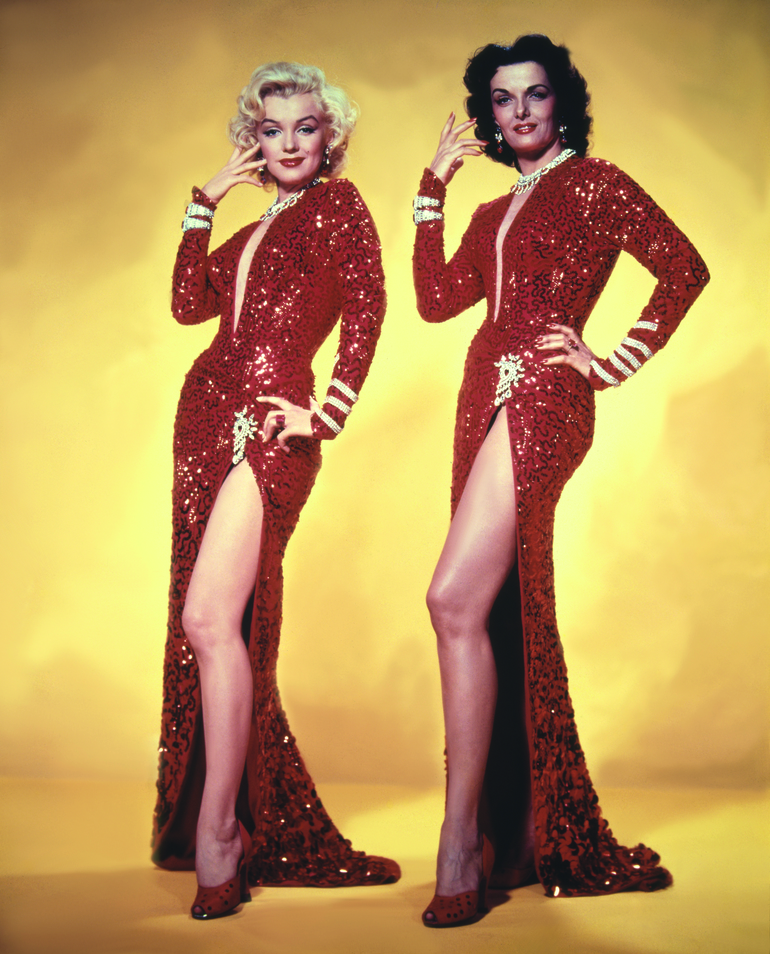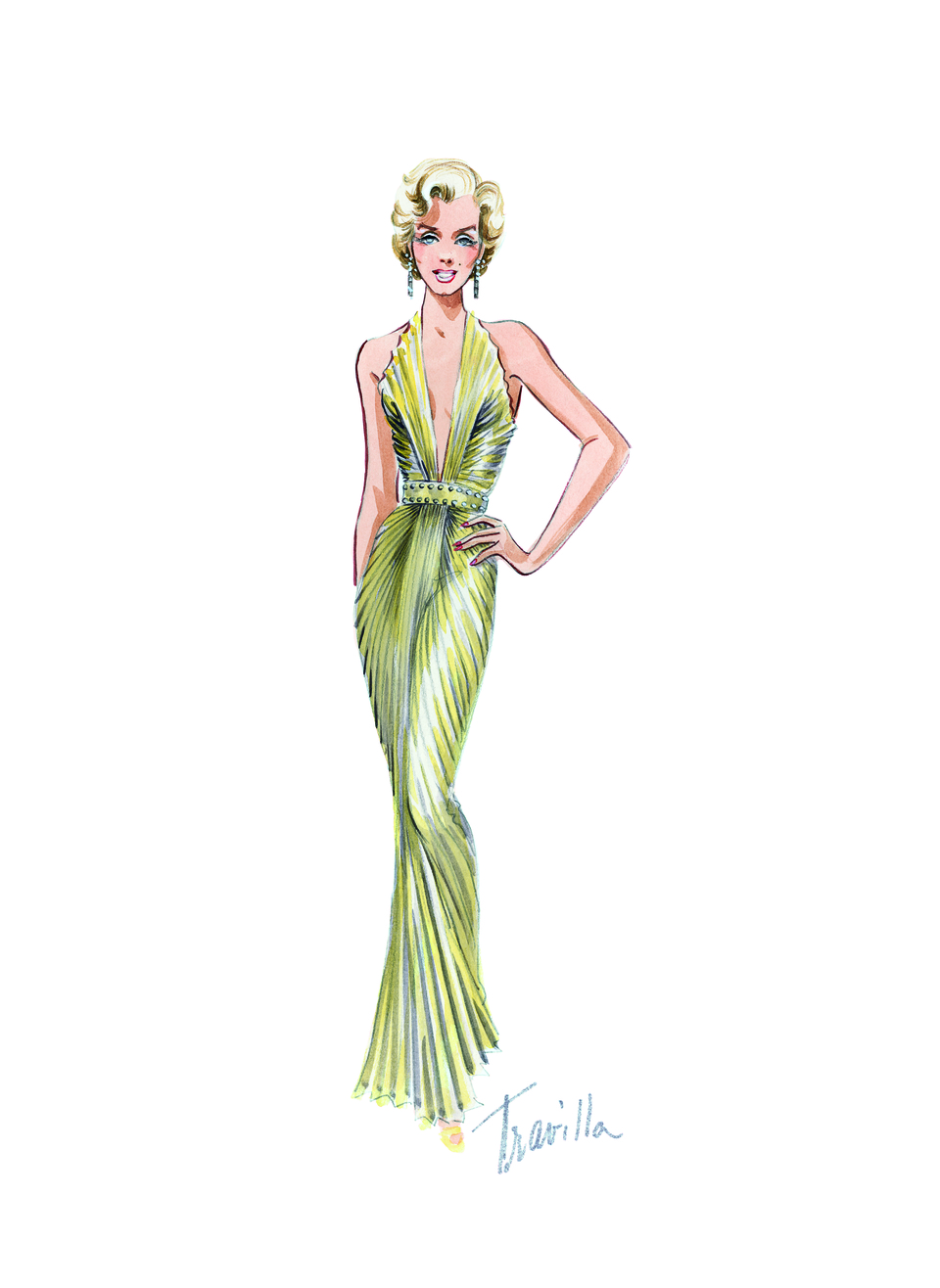Following the recent hit movie, ‘My Week with Marilyn’, the life and style of screen queen Marilyn Monroe looks set to take centre-stage later this year. As America’s most celebrated sex symbol, the MM image is recognised the world over and this August marks the 50th anniversary of the ultimate star’s untimely death. Perhaps surprisingly, her iconic looks, both off screen and on, were inspired by innovative Italian designers - and one Italian influenced film studio designer, in particular.
 Of her personal wardrobe classics, one of Marilyn’s all-time favourites was the film-star finish of a camel cashmere Maxmara coat. While off-duty, she adored the resort-wear trend of Capri pants, created in 1948 and named after Italy’s chicest island. Along with Grace Kelly and Audrey Hepburn, Marilyn popularised the ‘50s trouser trend abroad. By the early ‘60s, the easy luxury of Pucci’s slinky silk jersey pieces typified her look as she entered her mid ‘30s. She owned the signature simple and timeless tie-belt dress design in a whole colour palette from flesh tones to mauve; her favourite was said to be in vibrant lime, which poignantly aged just 36, she was buried in.
Of her personal wardrobe classics, one of Marilyn’s all-time favourites was the film-star finish of a camel cashmere Maxmara coat. While off-duty, she adored the resort-wear trend of Capri pants, created in 1948 and named after Italy’s chicest island. Along with Grace Kelly and Audrey Hepburn, Marilyn popularised the ‘50s trouser trend abroad. By the early ‘60s, the easy luxury of Pucci’s slinky silk jersey pieces typified her look as she entered her mid ‘30s. She owned the signature simple and timeless tie-belt dress design in a whole colour palette from flesh tones to mauve; her favourite was said to be in vibrant lime, which poignantly aged just 36, she was buried in.
Like most females, Marilyn adored shoes – in common with Sophia Loren and other stars, none more so than custom-fit Ferragamo’s. She owned many pairs - from simple white heels to ruby crystal courts similar to Judy Garland’s in ‘The Wizard of Oz’, and is forever linked with the brand’s inventive steel-reinforced stiletto. In honour of the well-shod blonde bombshell, from June, the Ferragamo museum in Florence is hosting a Marilyn themed exhibition featuring 14 pairs of their/her custom-made shoes.
It is interesting to wonder whether Marilyn had a feel for Italian style before absorbing any cultural influence from her second husband and lifelong friend, Italian American baseball star, Joe di Maggio. For a while in the ‘50s, they lived together in the bohemian Little Italy area of San Francisco.
 Movie-wise, Marilyn’s favourite siren style costumes were by one man: an Oscar-winning designer given an Italian-American mantle by film publicity, William Travilla. Though he dressed around 270 stars over fifty years - including Jane Russell, Betty Grable, Lauren Bacall, Joan Crawford, Errol Flynn, and later, Barbra Streisand, to the TV cast from 1980’s cult series, ‘Dallas’ – Travilla’s main claim to fame remains as Marilyn’s magical image-maker. The two fatefully met at 20th Century Fox studios in 1950, early in her career. Designing across eight of her films, his signature, sensuous imagery helped make Marilyn’s star shine. His famous glamour gowns for her include a trio from 1953’s ‘Gentlemen Prefer Blondes,’: the ‘Diamonds Are a Girl’s Best Friend’ candy pink satin - later copied in Madonna’s ‘Material Girl’ video; the daring gold ‘goddess’ lamé and the showgirl scarlet sparkler Marilyn wore, matching co-star Jane Russell, in the film’s opening number. He created the most iconic movie star dress of all time – the white, sunray-pleat skirt design ballooning over that subway grating in 1955’s ‘The Seven Year Itch’. It was seen as significant in Marilyn’s divorce from second husband Joe Di Maggio – apparently unhappy at his wife on show in such a way. Sold by owner actress Debbie Reynolds in 2011, it made a staggering $4.6 million – the highest amount ever paid for any movie costume.
Movie-wise, Marilyn’s favourite siren style costumes were by one man: an Oscar-winning designer given an Italian-American mantle by film publicity, William Travilla. Though he dressed around 270 stars over fifty years - including Jane Russell, Betty Grable, Lauren Bacall, Joan Crawford, Errol Flynn, and later, Barbra Streisand, to the TV cast from 1980’s cult series, ‘Dallas’ – Travilla’s main claim to fame remains as Marilyn’s magical image-maker. The two fatefully met at 20th Century Fox studios in 1950, early in her career. Designing across eight of her films, his signature, sensuous imagery helped make Marilyn’s star shine. His famous glamour gowns for her include a trio from 1953’s ‘Gentlemen Prefer Blondes,’: the ‘Diamonds Are a Girl’s Best Friend’ candy pink satin - later copied in Madonna’s ‘Material Girl’ video; the daring gold ‘goddess’ lamé and the showgirl scarlet sparkler Marilyn wore, matching co-star Jane Russell, in the film’s opening number. He created the most iconic movie star dress of all time – the white, sunray-pleat skirt design ballooning over that subway grating in 1955’s ‘The Seven Year Itch’. It was seen as significant in Marilyn’s divorce from second husband Joe Di Maggio – apparently unhappy at his wife on show in such a way. Sold by owner actress Debbie Reynolds in 2011, it made a staggering $4.6 million – the highest amount ever paid for any movie costume.
 For his part as her most-requested dresser, Marilyn wrote: ‘Billy Dear, please dress me forever. I love you, Marilyn.’ Travilla equally enthused on his muse: ‘…completely natural with the instincts of a feral cat and incandescent beauty that God seldom bestows on mere mortals… My clothes for Marilyn were an act of love. I adored her.’
For his part as her most-requested dresser, Marilyn wrote: ‘Billy Dear, please dress me forever. I love you, Marilyn.’ Travilla equally enthused on his muse: ‘…completely natural with the instincts of a feral cat and incandescent beauty that God seldom bestows on mere mortals… My clothes for Marilyn were an act of love. I adored her.’
Spokesperson for the late Travilla’s estate and UK author of ‘Dressing Marilyn,’ Andrew Hansford, takes up the tale.
Why do you think Travilla's Marilyn designs are so iconic over fifty years later?
‘All of Travilla’s designs are timeless: he was obsessed with classicism in design, from Grecian goddess pleating to fluid Italian style draping. Costumes were treated like couture: hand-sewn and made to perfection. Constructed from the inside out, he used boning, metal and fabric, with an architectural instinct. His skill was unlearned and he liked to think ‘outside the box’; the results were a dream but complex, impossible to replicate. When he started out in the ‘30s, he relied on creative vision and translated costuming into the new Technicolour and Cinemascope.
In Hollywood’s heyday, its fashion influence was massive; with bespoke studio costume design the USA’s answer to Euro-couture. Costume designers could transform actors into icons: dressing acted like star-dust and could make – or even, break – a big name. Travilla came on the scene to create the Marilyn movie illusion. Marilyn wasn’t yet well-known but she sought him out. She knew and loved his style – his designs were already acclaimed within the Hollywood elite.’
Why do many costumes made for Marilyn stand out, even from other stars?
‘On Marilyn especially, they really were ‘goddess’ gowns, cut to her God-given contours, enhanced with trademark drape or pleating. Like the gold lame pleated number, they became favourite styles she was sewn into and publicised in, on and off camera. She hated anything flowing as it wouldn’t show off her small yet full, hour-glass figure. Vanity sizing’s changed things but her size though shapely, is not as big as people think: probably closest to a UK size 8/10, her vital statistics averaged 37/22/36. Cinemascope had a widening effect disliked by actors. It could look aesthetically bad with the 1950s full skirted fashion. Her co-stars Lauren Bacall and Betty Grable agreed to wear this look, but Monroe did not – and stole the show in her trademark tight dresses!’
Why was there such a special chemistry between Travilla and Marilyn?
‘Both were charming and neither was pompous – even when Marilyn became massive. Somewhere between a little girl and an exhibitionist, Marilyn was fun and carefree, without the ego of a diva... Both liberal in politics, they were ahead of their time in terms of equality and civil rights – together risking trouble by visiting ethnic clubs in the days of racial segregation and so on. Clothes-wise, she enjoyed playing ‘dress-up’ with him… when it came to creating her ultimate look she trusted him as the best in the business. She commissioned him to create personal dresses for her – such as a white copy of the ‘Diamonds’ pink dress and he styled her skirt suit for her wedding to Joe Di Maggio.’
The tale of how you came by the Travilla collection is intriguing. Following his death in 1990 how did it cross your path?
‘I used to live in San Francisco and had a great friend I’d lost contact with. One day he popped up on MSN. I owned a beauty clinic in the UK that needed some marketing. He actually offered to send me a Marilyn dress for the window - as bequeathed to his good friend Bill Sariss, who was Travilla’s business partner. A week later, seven of Marilyn’s most famous dresses arrived on my doorstep: a priceless collection including the famous white, gold, pink and red designs plus three personal dresses. On trust, I was allowed to exhibit them in the UK in 1998 and 14,000 people turned up! I felt an utter fraud not knowing much on Marilyn at that stage - but grew to love the idea of her through the process that unfolded.’
You decided to take it further by writing your recent book on Travilla, ‘Dressing Marilyn’…
‘I felt it needed to continue and four or so years ago, I went to California to meet Bill Sariss. The Travilla estate was an eye-opener: some 600 sketches, 900 dresses on view. The book shows Marilyn’s key images: only 1% of the whole collection. I taped my interview with Bill - who had developed Alzheimer’s but was still clear on past facts - and he kindly decided that I could curate the collection and raise money for The Alzheimer’s Society. Bill simply wanted his talented friend Bill Travilla’s name to live on round the world.’
What interesting details did you discover about Travilla dressing Marilyn?
‘All the ‘ins and outs’ involved in design at the time: getting costumes past the film censors and making the right fabric choice for ‘glorious Technicolour’. The designer also had to know the character and the actor playing the character in order to create the best image. In addition, more than one original existed of most designs… it was standard practice to make three or four copies per film –they simply got dirty through filming and needed replacing. Also the fact that as Marilyn liked a ‘clean’ line to costume and clothes, he often had to in-build underwear!’
Will you be involved in any further Marilyn/Travilla related projects, for the 50th anniversary?
‘There’s a huge amount going on and I will be selective to see what’s tasteful and appropriate…The dresses are to be exhibited in LA later this year – though I would have liked to have shown them again outside of the States. However, it’s been really exhausting. I have enjoyed seeing the elation Marilyn’s dress presence has brought to people – but have been living in fear every time a bead falls off or hem comes undone! In need of the utmost care, no bank would insure the collection - so I kept it all laid flat in tissue paper underneath my bed, can you believe!’
****
Ferragamo museum: Florence www.salvatoreferragamo.it
****‘Dressing Marilyn’ by Andrew Hansford, published by Goodman/Carlton, available on-line.














